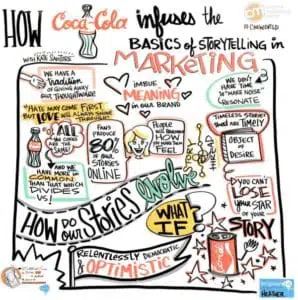At 4DP, we believe that every brand has a story to tell.
So what exactly is storytelling? A story about how your brand was founded, what drives your team, why your products and services are different from others and what you stand for are important narratives to tell your customers and prospective clients alike.
This is the story you want to tell your audience. People grow up with stories, from their childhood fairy tales to the guilty pleasure reality tv-shows they watch nowadays. Stories are an easy format to get your message to your audience, they’re easier to digest, and after all – they are more fun to engage with.
Storytelling is important for businesses of all sizes.
The big established brands like Coca-Cola still use storytelling to identify themselves with joy and pleasure and position themselves as the original. But also smaller sized companies can benefit from storytelling to put their company on the map. An emotional story about your early days, the way you want to change the world with your ideas and products or simply how fun your team is – it’s these stories that people can relate to, and that will spark their interest in what you have to offer.
Source: Content Marketing Institute
“Stories will help people to remember you. It will give you credibility. It will show your human side. And not to forget, it will change the way your customers see you.”
Reasons enough to focus on storytelling for your brand. But we know it might be hard for small businesses to include storytelling in their marketing mix. That’s why we want to give you some practical examples to keep in mind when creating your content strategy.
Make your story authentic
People don’t buy like bullshit. So don’t try to persuade your audience of a beautifully crafted story that you think would interest them but that actually doesn’t fit your company. Map out your values and ideas and try to let your story fit with these. Don’t sell yourself as a tree-hugging, sustainable and green company if you’re doing the opposite.
Your story continues everywhere
Make your story consistent, across all channels. With the importance of omni-channel marketing in mind, we have to ensure that the content we send out across all channels is aligned and contributes to the bigger picture. Don’t tell the ‘We’re one of you’-story on your Snapchat account while trying to position yourself as an ‘exclusive corporate company’ via your newsletters.
Get your customers involved
One-way communication is over. We are not just telling stories, but we want to interact with our customers alike. Let your customers contribute to your story, or even let them tell it with you through for example user-generated content campaigns.
Show your human side
Remember your favourite tales? They were the ones you could relate to, the ones that inspired you. A good business story for examples tells a human story about how the founder personally experienced a problem and created a solution for it, being the awesome product you’re trying to sell.
Pull those heartstrings
In line with your human side, make your story emotional. Your story has to touch people and move them. Think of the emotion you want to communicate when crafting your stories, whether this is emotionally moving or funny.
“I’ve learned that people will forget what you said, people will forget what you did, but people will never forget how you make them feel” – Maya Angelou


